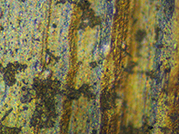Jul 6 2013
An international project has developed a response programme for rapidly restoring the use of drinking water networks following a deliberate contamination event.
 Biofilm on a metal coupon
Biofilm on a metal coupon
The importance of water and of water infrastructures to human health and to the running of our economy makes water systems likely targets for terrorism and CBRN (chemical, biological and radionuclide) contamination. Reducing the vulnerability of drinking water systems to deliberate attacks is one of the main security challenges.
SecurEau, a four-year Seventh Framework Programme funded project, involved 12 partners, including the University of Southampton, from six European countries. It has developed a toolbox that can be implemented by a major European city in response to a contamination event, which includes:
- tools for detecting water quality changes;
- methods for rapidly identifying the source(s) of intentional contamination;
- multi-step strategies for cleaning distribution systems;
- analytical methods for confirming cleaning procedure efficiency.
Research groups from the University of Southampton, the only UK partner in the project, developed new methods and technologies for detecting low levels of microbial and radiological contaminants and improving the efficiency of decontamination protocols, with special attention to the role of biofilms.
The SecurEau team developed water quality sensors to be installed in a drinking water system, which allows an alert to be issued rapidly when abrupt changes in the quality of water are detected. These were confirmed by development of specific molecular tools by Southampton and several other partners.
The team also developed ‘sentinel coupons’ of polymeric materials to be installed in water distribution systems for deposits and biofilms to form on their inner surface. The coupons would be installed in the water supply system to monitor the concentration of the pollutant absorbed onto the like pipe walls. They would then be used to validate the cleaning procedures applied throughout the network during the crisis phase but also during ‘normal’ operation of the network.
Project partners also developed mathematical models to determine the areas which have been contaminated and the sources of contamination, and various cleaning methods, both traditional and new ones, to be applied to decontaminate the network.
Professor Bill Keevil, Director of Environmental Healthcare at the University of Southampton, says: “If a contamination event (accidental or deliberate) occurs in a drinking water network, it is essential to identify the sources of contamination and to determine the area which is likely to be contaminated, in order to isolate and decontaminate the affected area only, as well as keep supplying drinking water in non-affected areas.
“Our experiments show that coupon-monitoring devices are suited to follow deposit / biofilm formation in drinking water distribution systems as well as to investigate and confirm the successful removal of deposits from surfaces.”